Uncertainly Analysis of Two Types of Humidity Sensors by a Humidity Generator with a Divided-Flow System
Abstract
:1. Introduction
2. Sources of the Uncertainty of Humidity Sensors
2.1. Uncertainty of the Reference Standard
2.2. Uncertainty Due to Nonlinearity and Repeatability
2.3. Uncertainty Due to Resolution
2.4. Uncertainty Due to Temperature Variation and Hysteresis
2.5. Uncertainty Due to Calibration Equation
2.6. The Combined Standard Uncertainty
3. Materials and Method
3.1. The Divided-Flow System
3.2. Sensors
3.3. Calibration to Standard Humidity System
3.4. Establishment of the Calibration Equation
4. Results
4.1. Calibration Equations of the Resistive Humidity Sensor
- a.
- Linear equation
- b.
- 3rd order polynomial equation
4.2. Calibration Equation of the Capacitive Humidity Sensor
- a.
- Linear equation
- b.
- 3rd order polynomial equation
4.3. The Uncertainty of Reference Standard
4.4. The Combine Standard Uncertainty of the Resistive Humidity Sensor
- a.
- Uncertainty from nonlinearity and repeatability
- b.
- Uncertainty from resolution
4.5. The Combined Standard Uncertainty of the Capacitive Humidity Sensor
- Uncertainty from nonlinearity and repeatability
- Uncertainty from resolution
5. Discussion
6. Conclusions
Acknowledgments
Author Contributions
Conflicts of Interest
References
- Wernecke, R.; Wernecke, J. Industrial Moisture and Humidity Measurement: A Practical Guide; Wiley: Hoboken, NJ, USA, 2014. [Google Scholar]
- Harriman, G.L., III; Lstiburek, J.W. ASHRAE Guide for Buildings in Hot and Humid Climates, 2nd ed.; ASHRAE: Atlanta, GA, USA, 2009. [Google Scholar]
- Boulard, T.; Wang, S. Greenhouse crop transpiration simulation from external climate conditions. Agric. Forest Meteorol. 2000, 100, 25–34. [Google Scholar] [CrossRef]
- Wiederhold, P.R. Water Vapor Measurement: Methods and Instrumentation; Marcel Dekker, Inc.: New York, NY, USA, 1997. [Google Scholar]
- Huang, P. Determining uncertainties of relative humidity, dew/frost-point temperature, and mixing ratio. In Proceedings of the Third International Symposium on Humidity and Moisture, Teddington, UK, 6–8 April 1998. [Google Scholar]
- Greenspan, L. Humidity fixed points of binary saturated aqueous solutions. J. Res. Nat. Bur. Stand. A 1977, 81A, 89–96. [Google Scholar] [CrossRef]
- Lu, H.; Chen, C. Uncertainty evaluation of humidity sensors calibrated by saturated salt solutions. Measurement 2007, 40, 591–599. [Google Scholar] [CrossRef]
- Hardy, B. Relative Humidity Uncertainty Analysis of the Thunder Scientific Model 2500 Two-Pressure Humidity Generator; Thunder Scientific Corporation: Albuquerque, NM, USA, 1998. [Google Scholar]
- Heinonen, M. A humidity generator with a test chamber system. Measurement 1999, 25, 307–313. [Google Scholar] [CrossRef]
- Martins, L.; Ribeiro, A.S.; Sousa, J.A.; Forbes, A.B. Measurement uncertainty of dew-point temperature in a two-pressure humidity generator. Int. J. Thermophys. 2012, 33, 1568–1582. [Google Scholar] [CrossRef]
- Hardy, B. Trust but verify–practical approaches to humidity generation and measurement. In Proceedings of the 9th International Symposium on Temperature and Thermal Measurement in Industry and Science, Cavtat-Dubrovnik, Croatia, 21–25 June 2004; Volume 1, pp. 23–32. [Google Scholar]
- Heinonen, M. The CMA humidity standard. Measurement 1996, 17, 183–188. [Google Scholar] [CrossRef]
- Ahmed, M.G.; Mazen, S.; El-Gelil, D.A.; El Sayed, N.I. Realization of relative humidity scale using NIS two-temperature humidity generator. J. Phys. Sci. Appl. 2014, 4, 484–487. [Google Scholar]
- El-Gelil, D.A.; Ahmed, M.G. Consistency of the national realization of dew-point temperature using NIS standard humidity generators. Int. J. Metrol. Qual. Eng. 2017, 8, 1–6. [Google Scholar] [CrossRef]
- Takahashi, C.; Kitano, H. Calibration method of flow meters for a divided flow humidity generator. Sens. Actuator B Chem. 1996, 36, 522–527. [Google Scholar] [CrossRef]
- Milosevic, N.D.; Stepanic, N.M.; Babic, M.M. A relative humidity calibration from 5 °C to 45 °C in a mixed-flow humidity generator. Therm. Sci. 2012, 16, 193–205. [Google Scholar] [CrossRef]
- Dias, S.D.I. Two-flow system for calibration of hygrometers at room temperature. Master’s Thesis, University of Tartu, Tartu, Estonia, 2015. [Google Scholar]
- Su, P.; Wu, R. Uncertainty of humidity sensors testing by means of divided-flow generator. Measurement 2004, 36, 21–27. [Google Scholar] [CrossRef]
- ISO/IEC 98–3. Uncertainty of Measurement—Part 3: Guide to the Expression of Uncertainty in Measurement; ISO Edition: Geneva, Switzerland, 2010. [Google Scholar]
- National Aeronautics and Space Administration. Measurement Uncertainty Analysis Principles and Methods, NASA Measurement Quality Assurance Handbook—Annex 3; National Aeronautics and Space Administration: Washington, DC, USA, 2010.
- Grabe, M. Measurement Uncertainties in Science and Technology, 2nd ed.; Springer: Heidelberg, Germany, 2005; pp. 3–9. [Google Scholar]
- Hardy, B. Relative Humidity Uncertainty Analysis Using Dew/Frost Point Measurements; RH Systems: Albuquerque, NM, USA, 1998. [Google Scholar]
- Lin, X.; Hubbard, K.G. Uncertainties of derived dewpoint temperature and relative humidity. J. Appl. Meteorol. Climatol. 2004, 43, 821–825. [Google Scholar] [CrossRef]
- Orlando, A.F.; Brionizio, J.D.; Lima, L.A. Calculation of humidity parameters and uncertainties using different formulations and softwares. In Proceedings of the 5th International Symposium on Humidity and Moisture, Rio de Janeiro, Brazil, 2–5 May 2006. [Google Scholar]
- Mathioulakis, E.; Panaras, G.; Belessiotis, V. Estimation of uncertainties in indirect humidity measurements. Energy Build. 2011, 43, 2806–2812. [Google Scholar] [CrossRef]
- Chen, J.; Chen, C. Uncertainty analysis in humidity measurements by the psychrometer method. Sensors 2017, 17, 368. [Google Scholar] [CrossRef] [PubMed]
- Matko, V.; Milanović, M. Temperature-Compensated Capacitance-Frequency Converter with High Resolution. Sens. Actuators A Phys. 2014, 220, 262–269. [Google Scholar] [CrossRef]
- Pascariu, P.; Airinei, A.; Olaru, N.; Petrila, I.; Valentin Nica, V.; Sacarescu, L.; Tudorache, F. Microstructure, electrical and humidity sensor properties of electrospun NiO–SnO2 nanofibers. Sens. Actuators B Chem. 2016, 222, 1024–1031. [Google Scholar] [CrossRef]
- Stevens, M.; Collier, T.; Harris, R. Comparison of Instruments for Measuring Relative Humidities; NPL Report CBTLM 6; National Physical Laboratory: Teddington, UK, 2000; pp. 1469–4921. [Google Scholar]
- OMIL, The scale of Relative Humidity of Air Certified Against Saturated Salt Solutions. Available online: https://www.healthpack.net/files/SaltSolutions.pdf (accessed on 21 February 2018).
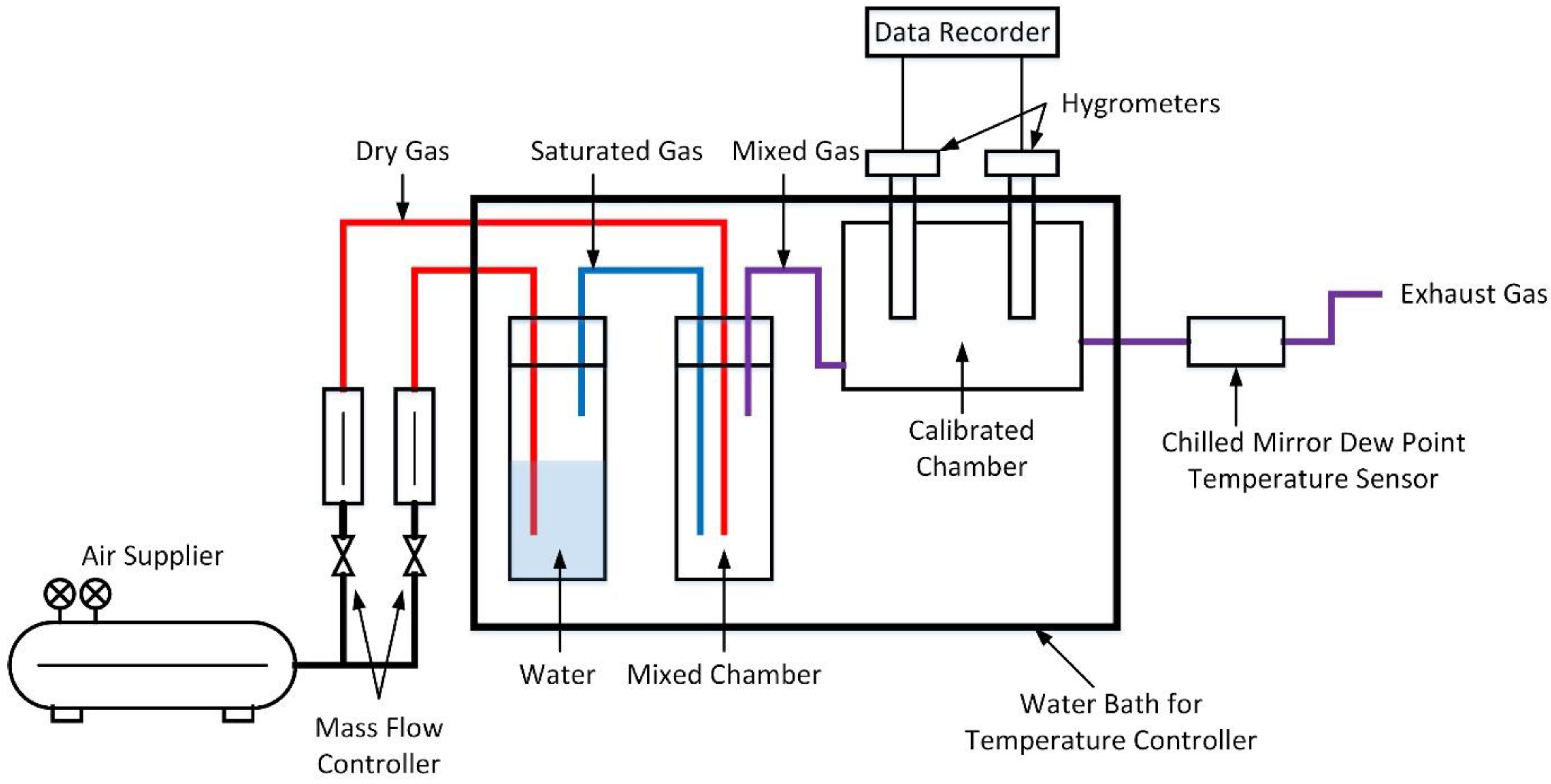


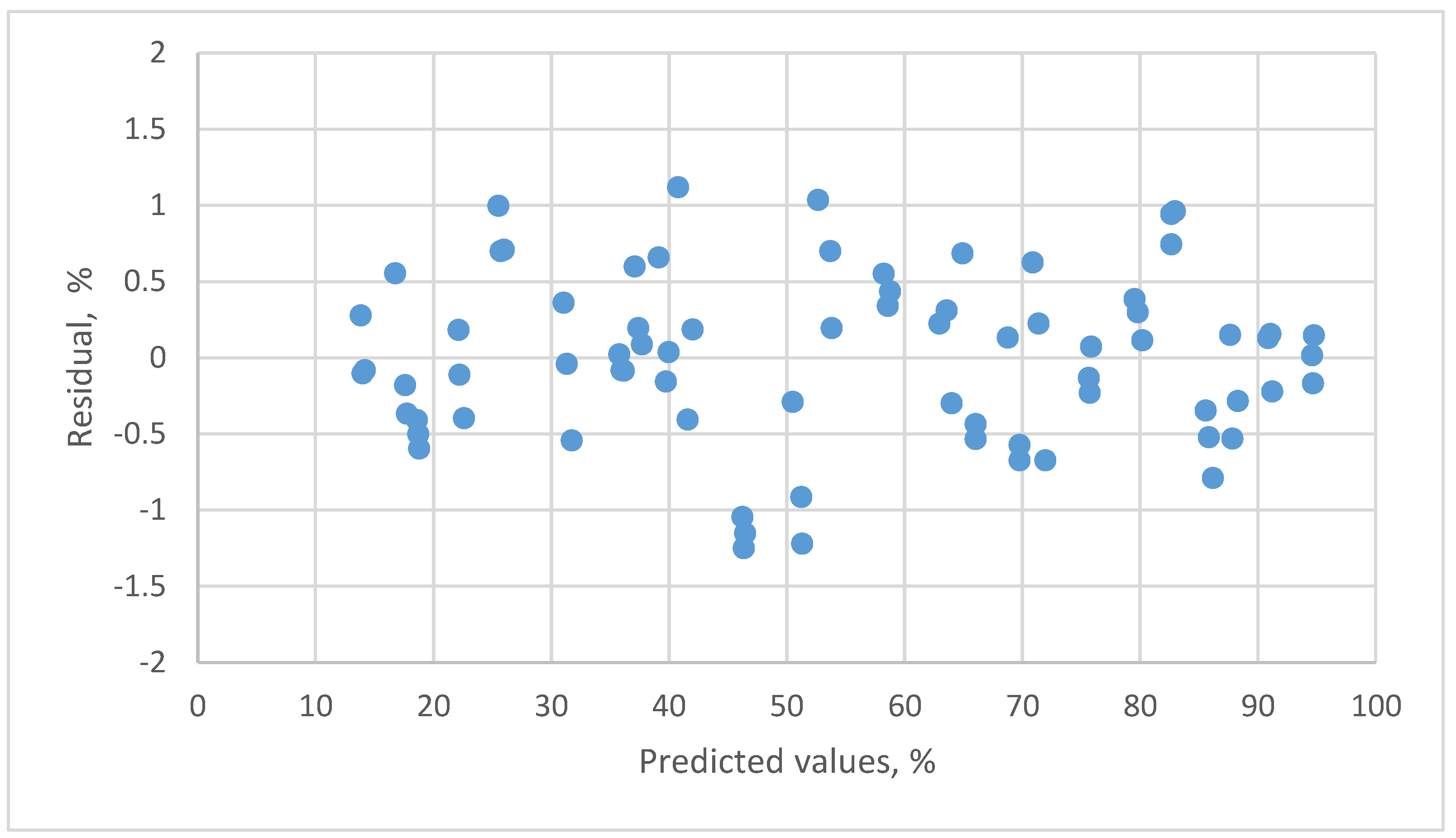
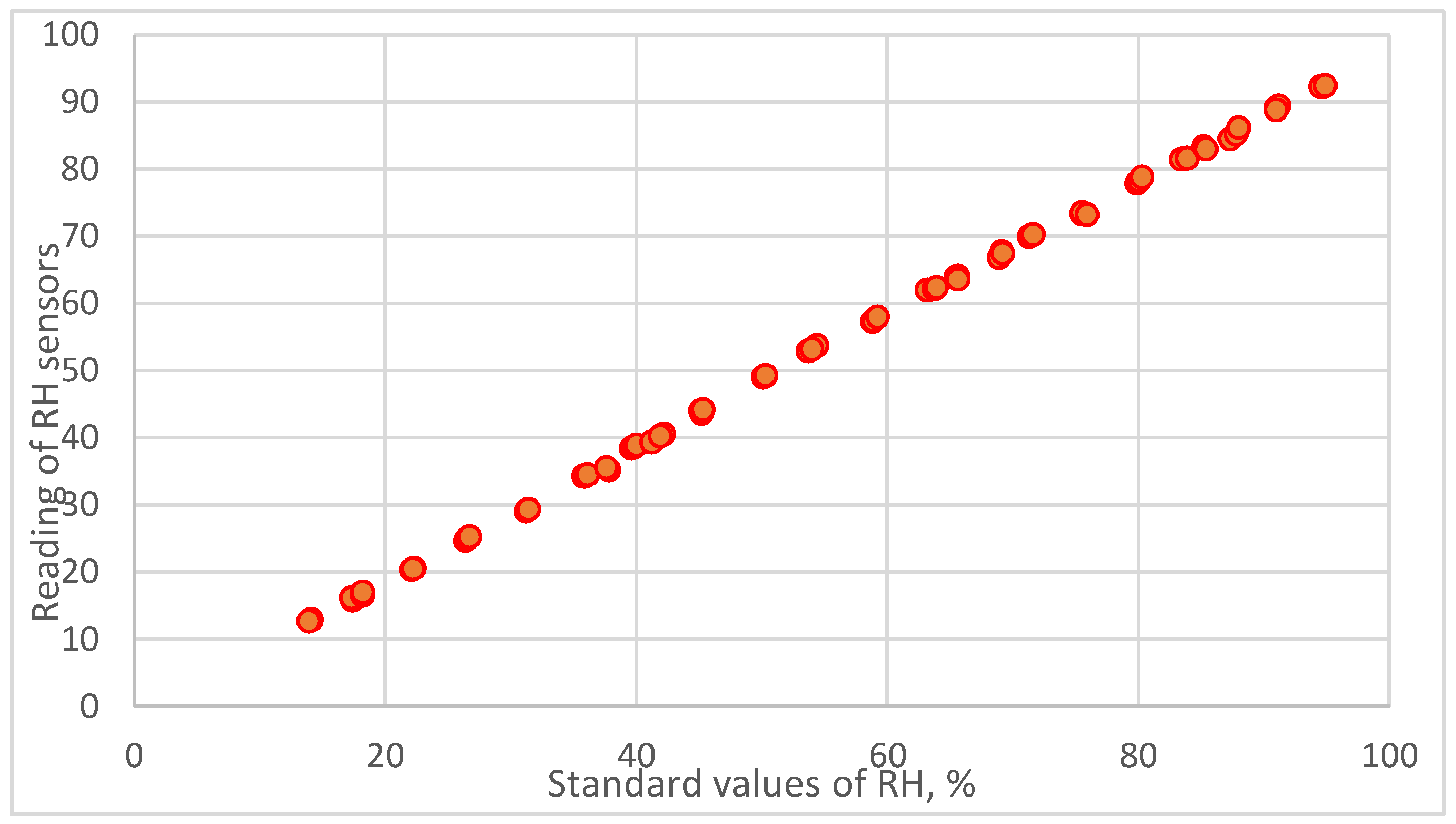

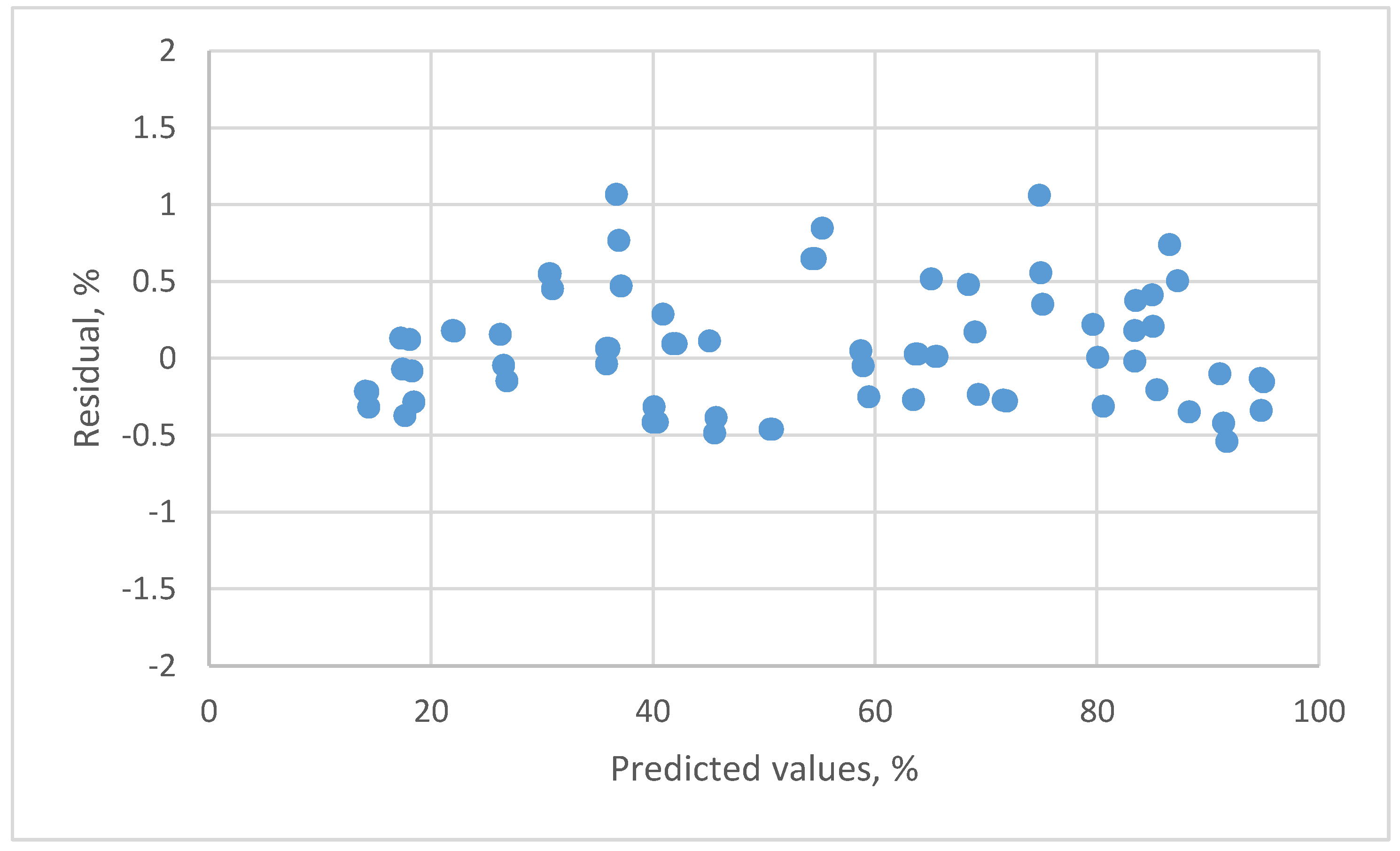
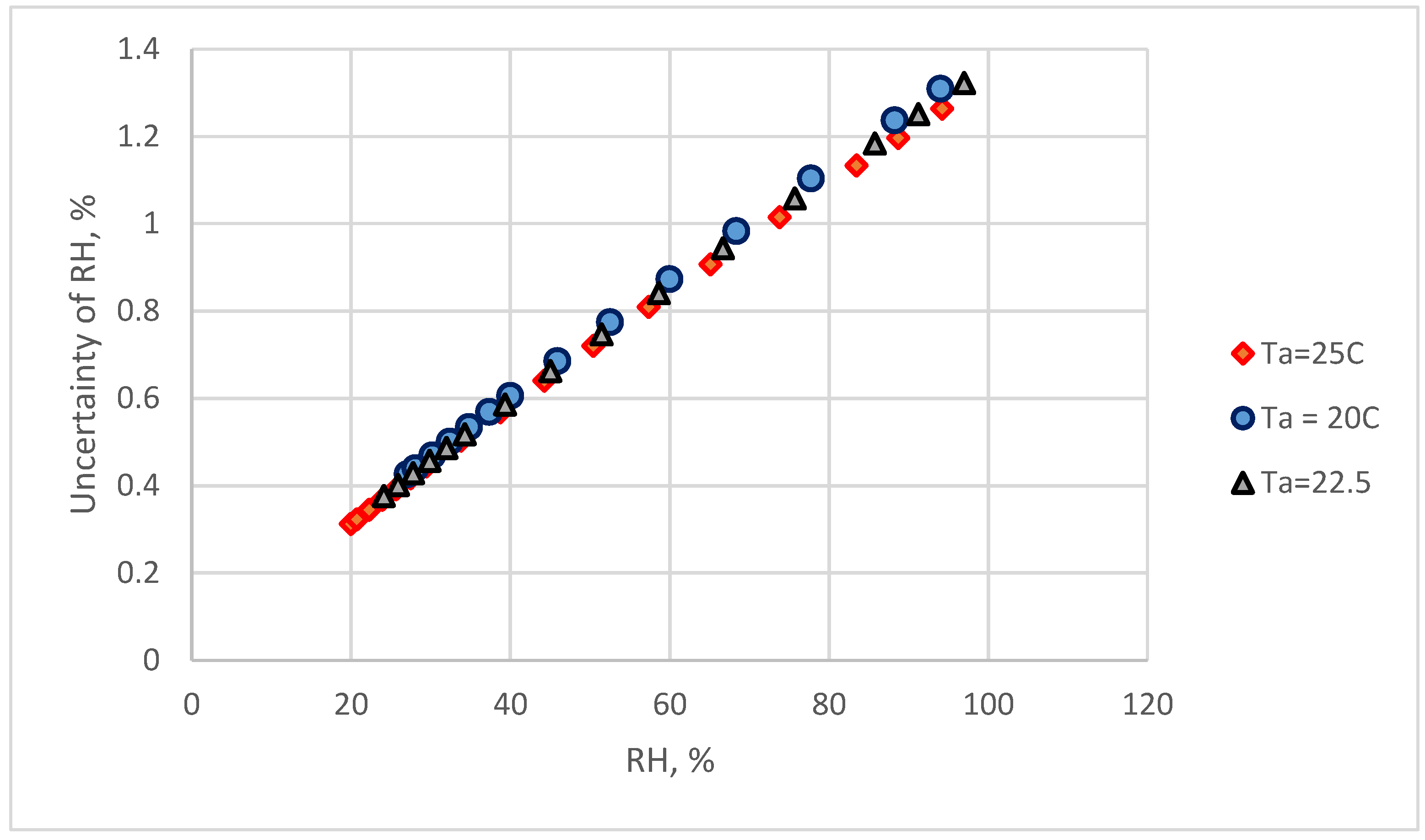
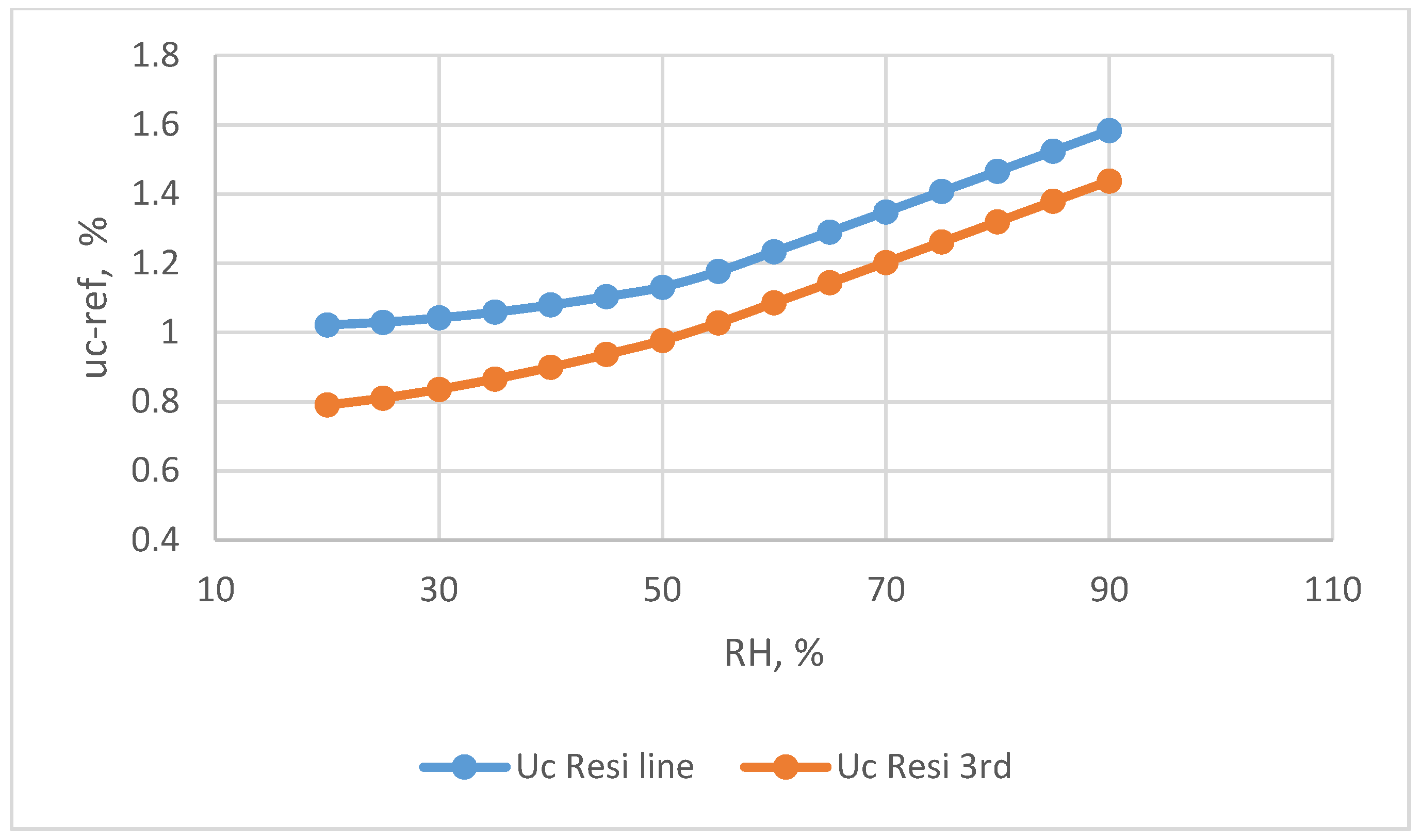
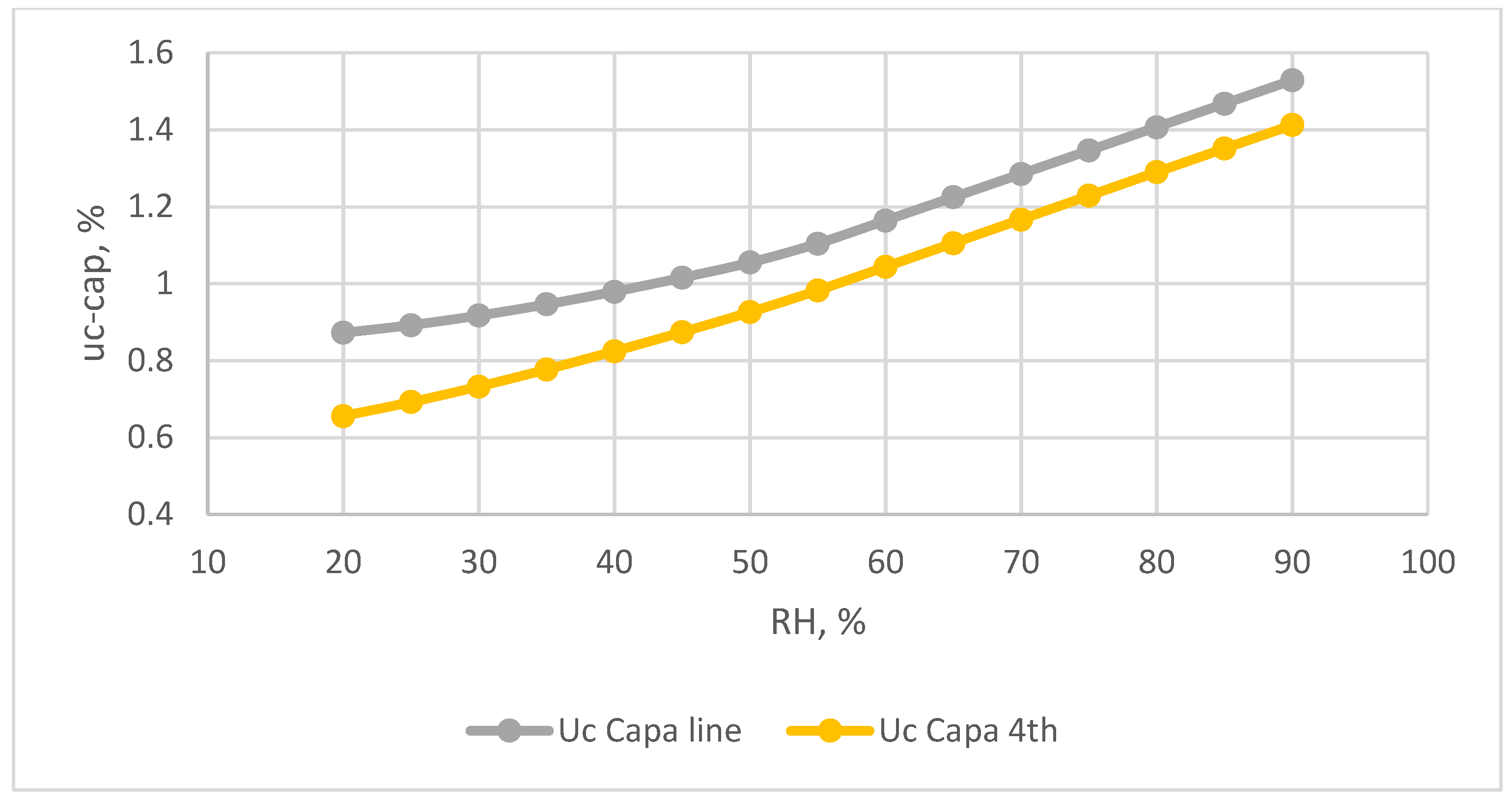
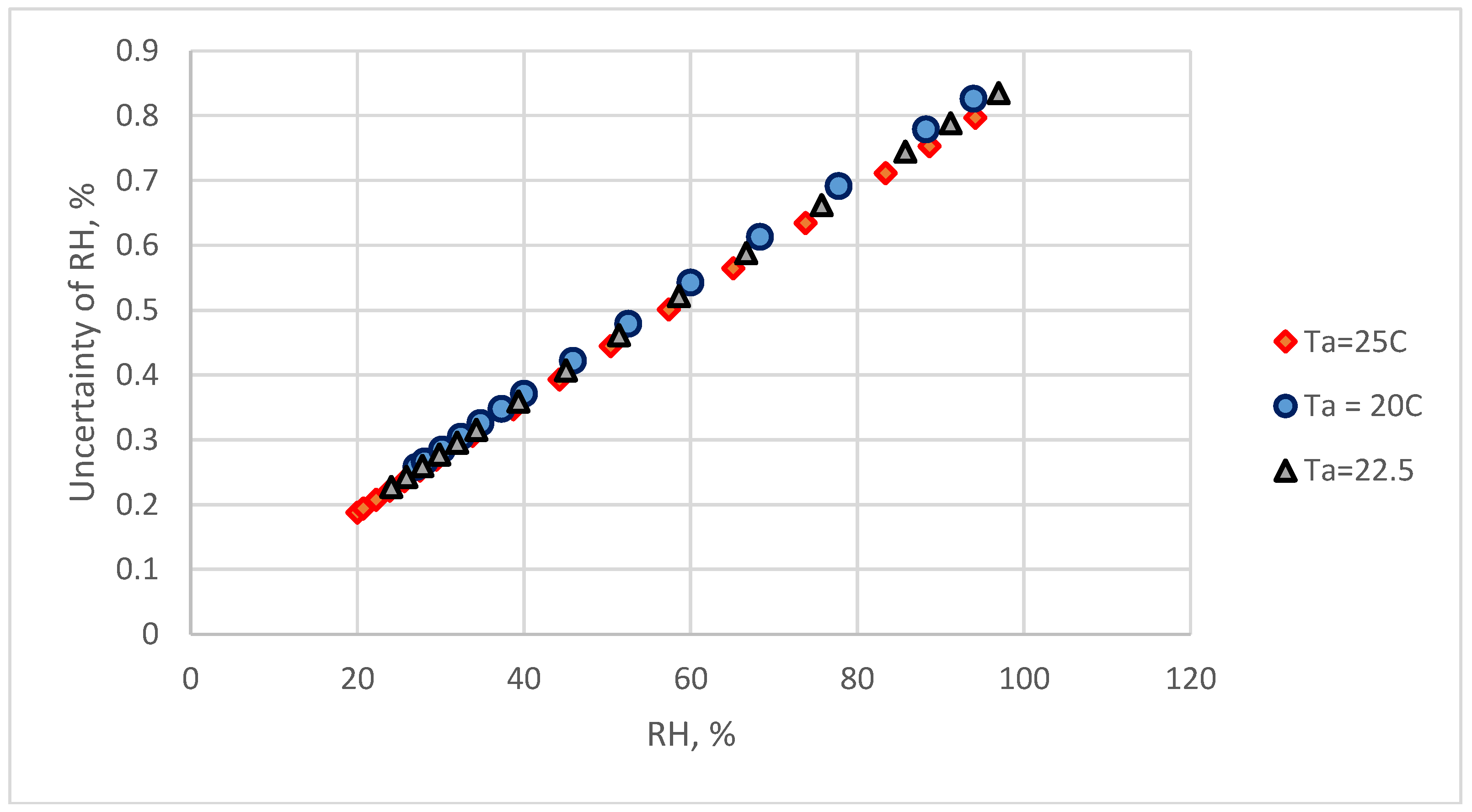
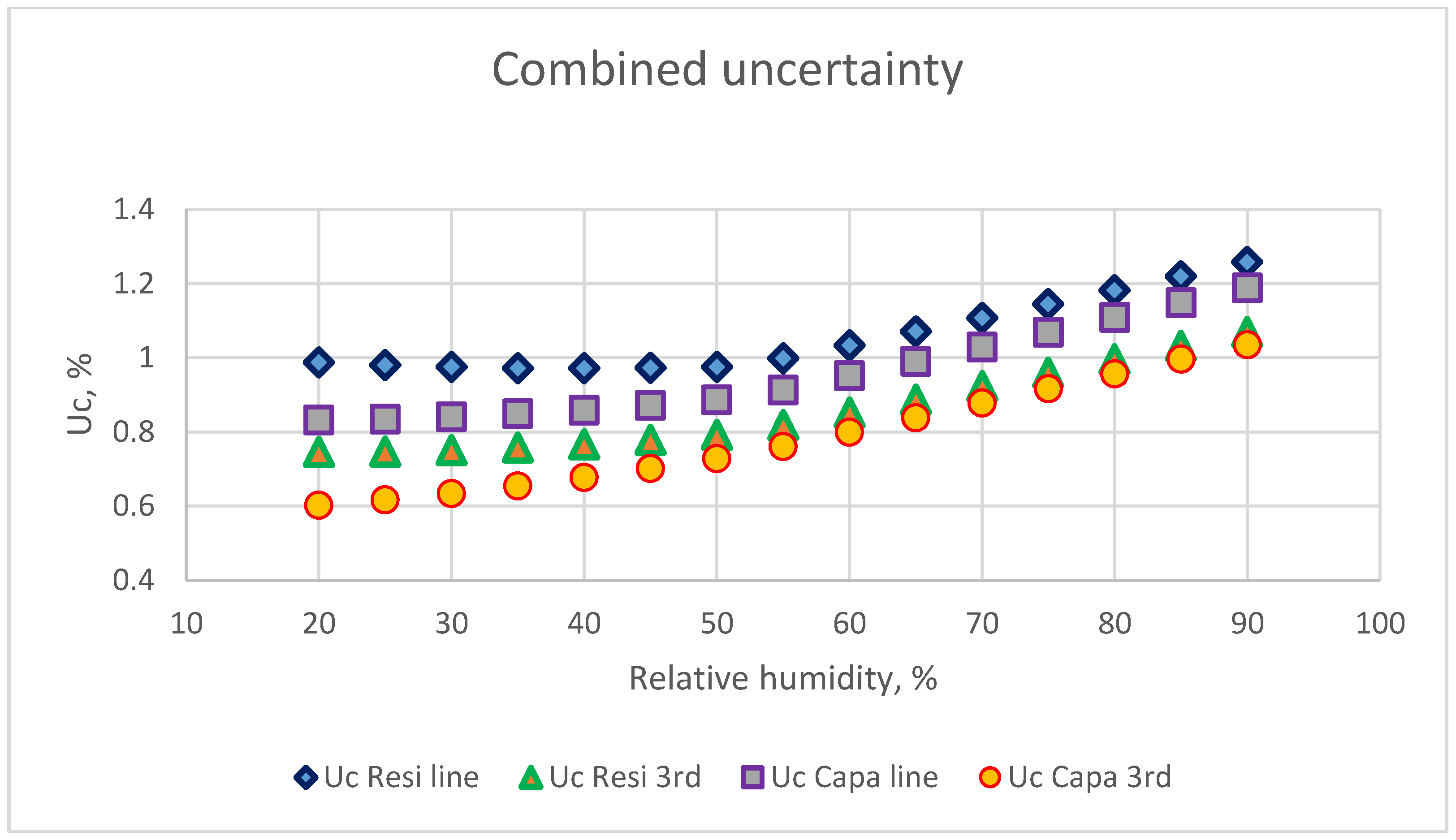
| Dew Point Temperature | Resistive Humidity Sensor | Capacitive Humidity Sensor | |
|---|---|---|---|
| Sensing element | Chilled mirror sensors | Macro-molecular Resistive element | Hamicap Capacitive-type |
| Measuring range | −80~85 °C 0.003~100% RH (Relative humidity) | 0~99% RH | Thin-film polymer element 0~100% RH |
| Nonlinearity and repeatability | ±0.05 °C | 1.0% RH | (1.0 + 0.008* Reading value)% RH |
| Resolution | 0.1 °C | 0.1% RH | 0.1% RH |
| Accuracy | Dew point temperature ±0.2 °C Air temperature ±0.1 °C (After calibration) | ±2.0%, 20~90% RH | ±1% RH, 0~90% RH |
© 2018 by the authors. Licensee MDPI, Basel, Switzerland. This article is an open access article distributed under the terms and conditions of the Creative Commons Attribution (CC BY) license (http://creativecommons.org/licenses/by/4.0/).
Share and Cite
Chen, L.-H.; Chen, C. Uncertainly Analysis of Two Types of Humidity Sensors by a Humidity Generator with a Divided-Flow System. Sensors 2018, 18, 637. https://doi.org/10.3390/s18020637
Chen L-H, Chen C. Uncertainly Analysis of Two Types of Humidity Sensors by a Humidity Generator with a Divided-Flow System. Sensors. 2018; 18(2):637. https://doi.org/10.3390/s18020637
Chicago/Turabian StyleChen, Ling-Hsi, and Chiachung Chen. 2018. "Uncertainly Analysis of Two Types of Humidity Sensors by a Humidity Generator with a Divided-Flow System" Sensors 18, no. 2: 637. https://doi.org/10.3390/s18020637





